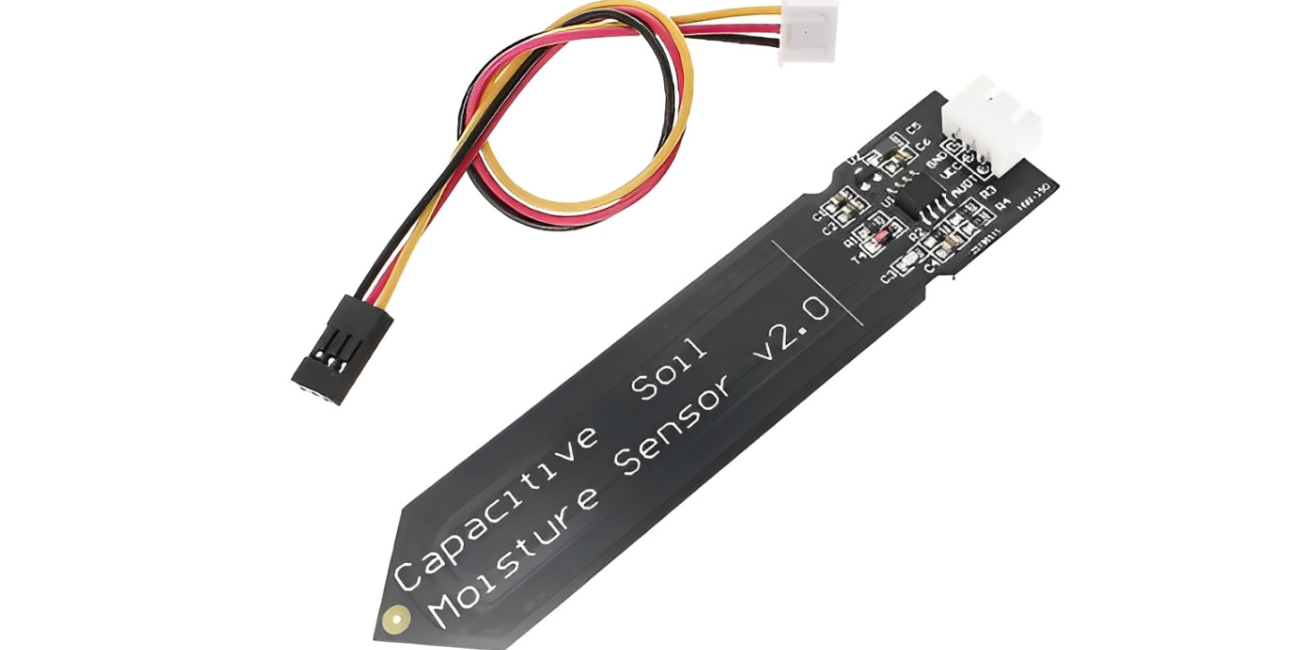The Unseen Hero in Your Garden: Why Every Plant Lover Needs a Capacitive Soil Moisture Sensor V2.0
You know that sinking feeling when your favorite houseplant starts wilting, or your meticulously planned vegetable patch looks less than vibrant? Or perhaps you're tired of the endless guessing game: Is it too much water? Not enough? That's often when you realize you're dealing with the fundamental challenge of plant care – understanding what's truly happening beneath the soil surface.
Enter the unassuming, yet utterly indispensable, Capacitive Soil Moisture Sensor V2.0. Trust me, if you're serious about plant care, smart gardening, or any kind of DIY plant monitoring, this little gadget is about to become your new best friend. It’s not just a component; it’s your essential interpreter, making sure you know exactly when your green companions are thirsty, preventing both overwatering and drought stress. For anyone looking for a reliable soil moisture sensor, an accurate soil moisture sensor, or a versatile corrosion-resistant soil sensor, read on!
So, What Exactly Is This Little Gizmo Doing for Your Plants?
Think of your plant's roots and the soil around them as having a secret language about hydration. Traditional methods like sticking your finger in the dirt can be misleading. Resistive soil moisture sensors, while seemingly simple, have a fatal flaw: they pass a continuous electric current through the soil. This leads to electrolysis, which corrodes their metal probes over time, giving you increasingly inaccurate readings and a short lifespan.
The Capacitive Soil Moisture Sensor V2.0 steps in as the perfect, long-lasting translator. It houses clever circuitry that works tirelessly behind the scenes:
- Corrosion Crusader: This is its superpower. Unlike older resistive sensors, the V2.0 uses capacitive sensing. It doesn't put electricity directly into the soil. Instead, it measures the soil's "dielectric permittivity" – essentially how well it stores an electric field. Since water significantly changes this property, the sensor can accurately gauge moisture levels without direct metal-to-soil contact. No electrolysis means no corrosion, ensuring extended lifespan and consistent performance.
- Moisture Magician: It seamlessly converts the soil's moisture level into an analog voltage signal. Drier soil typically results in a higher voltage output, while wetter soil lowers the voltage. This makes it incredibly easy to interpret and interface with microcontrollers like Arduino, ESP32, or Raspberry Pi (with an ADC module). It's a fantastic accurate soil moisture tool to peek inside your pots and garden beds and see what's truly going on.
Essentially, this tiny board lets your microcontroller act like a highly sensitive moisture meter, but with the convenience and precision needed for automation. It's a fantastic DIY plant monitoring device to truly understand your plants' needs.
Why the Capacitive Soil Moisture Sensor V2.0 Earns Its Spot in Your Garden Toolkit
We're all looking for tools that simplify our lives and make our hobbies more rewarding, right? The Capacitive Soil Moisture Sensor V2.0 delivers on that promise for a few solid reasons:
- Plays Well with Everyone: Its broad compatibility is a huge win. From Arduino soil sensor projects to full-blown smart home automation systems, or even simple automatic irrigation setups – if you need to measure soil moisture, this soil humidity sensor can likely connect to it. It’s genuinely a versatile plant sensor.
- Budget-Friendly Brilliance: You can buy Capacitive Soil Moisture Sensor V2.0 modules without emptying your wallet. They're incredibly affordable, making them perfect for students and hobbyists, but also a smart, cost-effective choice for professionals who need reliable data for agricultural sensors projects.
- Plug-and-Play (Mostly!): Once you've made the simple connections (VCC, GND, and Analog Out), it just starts providing data. Then, any standard microcontroller can read its output. Many online Capacitive Soil Moisture Sensor V2.0 Arduino tutorials are available, making setup a breeze.
- Small Footprint, Big Impact: This thing is tiny! It takes up hardly any space in your pot or garden bed, and its compact nature makes it easy to integrate into more permanent setups or just toss into your grab-and-go gardening tools. It's a truly portable soil sensor.
- Stable and Reliable: The lack of corrosion means readings remain stable over long periods, unlike resistive sensors that degrade quickly. This consistency is vital for setting up reliable automatic irrigation systems.
Bringing Your Green Ideas to Life: Real-World Uses for the Capacitive Soil Moisture Sensor V2.0
The possibilities with the Capacitive Soil Moisture Sensor V2.0 are genuinely exciting for any plant care enthusiast or smart home tinkerer:
- Automated Watering Systems: This is its bread and butter. Connect it to an Arduino and a water pump, and you can create a system that waters your plants only when they truly need it, saving water and preventing overwatering. Essential for any automatic irrigation project.
- Indoor Plant Monitoring: Ever forgotten to water your indoor plants? Place a sensor in each pot and connect them to a central display or an app on your phone, giving you real-time alerts. Perfect for smart gardening.
- Optimizing Garden Yields: In larger agricultural sensors applications, knowing precise soil moisture can help farmers optimize irrigation, leading to healthier crops and better yields while conserving water resources.
- Science Projects & Education: Its simplicity and effectiveness make it an excellent tool for educational projects demonstrating environmental sensing and basic electronics.
- Terrarium & Vivarium Management: Maintain perfect humidity levels for exotic plants or animals by integrating this sensor into automated misting or ventilation systems.
- Data Logging for Analysis: Hook up a sensor to a data logger, and you can track moisture trends over days or weeks, helping you understand your specific soil and plant needs.
Getting Started: Just a Few Friendly Pointers
- Power Wisely: Most V2.0 sensors operate between 3.3V and 5V. Always ensure you connect the VCC pin to the correct voltage supply on your microcontroller.
- Analog Input: Connect the sensor's Analog Output pin to an analog input on your microcontroller (e.g., A0 on Arduino).
- Calibration is Key: While the sensor provides readings, soil types vary wildly. To get meaningful data, you'll need to calibrate Capacitive Soil Moisture Sensor V2.0. Take a reading when the sensor is in completely dry soil, and another when it's in saturated soil. These min/max values will allow you to convert the analog output into a percentage or meaningful moisture level.
- Placement Matters: For the most accurate readings, place the sensor away from the pot's edge and ensure it's firmly inserted into the root zone. Avoid direct contact with fertilizer, as high salt content can influence readings.
Conclusion: Your Reliable Handshake to a Greener World
The Capacitive Soil Moisture Sensor V2.0 isn't just another electronic component; it's your reliable handshake to the thriving world of happy, healthy plants. Its affordability, straightforward nature, and unparalleled corrosion resistance make it an absolute workhorse for anyone from curious beginners to seasoned plant enthusiasts. If you're growing, monitoring, or just plain tinkering, having this versatile soil moisture sensor in your toolkit will save you countless headaches and open up a whole new realm of possibilities for efficient plant care. It’s a small investment that delivers huge capabilities for sustainable gardening.

